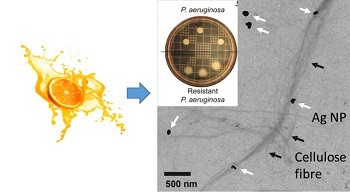Squeezing more than just orange juice: antimicrobial sustainable cellulose
Researchers in Green Chemistry have developed antimicrobial applications for waste citrus peel, potentially enabling the greater use of this resource in a circular economy.

Since the discovery of penicillin, pharmaceutical companies have produced antibiotics on a large scale to fight bacterial infections. Unfortunately, the misuse of these antimicrobial compounds has created a selective pressure in favour of antibiotic-resistant bacteria, leading to an overall increase of antimicrobial resistance (AMR). The World Health Organization (WHO) have campaigned against the threat of AMR with numerous initiatives, and the search for new or alternative antimicrobial agents is a global grand challenge.
In research just published in Nature Scientific Reports, Dr Avtar Matharu, Dr Tom Dugmore and Dr Eduardo de Melo from the Green Chemistry Centre of Excellence, together with colleagues from Universidad Autónoma de Nuevo León (UANL) in Mexico, reported a novel nano-silver biocomposite derived from waste orange peel. This material shows antimicrobial activity against clinical multidrug-resistant strains, with stronger antimicrobial activity against Gram negative than Gram positive bacteria.
Cellulose is the most abundant biopolymer on earth – naturally-derived and biodegradable. Furthermore, food supply chains have unavoidable waste, such as citrus peel, which is often simply discarded, yet can be an excellent source of cellulose. Importantly, cellulose is also an interesting scaffold for antimicrobial agents. Using waste as a resource enables the development of a circular economy, and aligns with UN Sustainable Development Goals.
The combination of York’s ability to produce ‘sustainable cellulose’ using microwave technology with skills of Professor Ruben Morones-Ramirez and colleagues at UANL to incorporate nanoscale silver produced a novel biocomposite with exceptional antimicrobial activity. In this way, the researchers manage to squeeze more out of an orange than just orange juice.
Dr Avtar Matharu said, “This is an exciting collaboration for us with colleagues at UANL and demonstrates the power of networking. It is great to see materials investigated by Eduardo during his PhD studies at Science without Borders making an impact. Our composite has interesting potential healthcare applications and we are delighted to be doing our part to combat antimicrobial resistance.”
Dr Tom Dugmore added, “We've spent a lot of time on reducing the environmental footprint on production of these materials from food waste, but a question always remains about how well they will ultimately perform. It was great to get positive results, particularly in such an important field.”
The research is published open access in Scientific Reports.